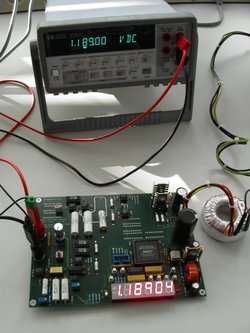Voltmeter
|
|
A voltmeter is a measuring instrument for measuring the voltage between two points in an electric circuit.
Many voltmeters are in fact very high resistance ammeters. Hence the design of the instrument is identical to that of an ammeter except that one of the design objectives of the instrument is to disturb the circuit as little as possible and hence the instrument should draw a minimum of electric current to operate. The moving coil galvanometer is one example of this type of voltmeter. It employs a small coil of fine wire suspended in a strong magnetic field. When electricity is applied it rotates and compresses a small spring. The angular rotation is proportional to the current that is flowing through the coil. For use as a voltmeter a series resistance is added so that now the deflection becomes proportional to the applied voltage.
Other methods for measuring voltage include the potentiometer, and the oscilloscope.
The potentiometer method of measuring voltage uses a length of uniform resistance wire held straight and with a DC voltage applied across the wire. A voltage source is connected to one end of the wires and to a sliding connection on the wire via some form of current detector. The slider is adjusted until a balance is obtained and no current is detected. At this setting the length of wire from the end connected to the voltage source up to the slider is measured. This procedure is repeated both for a source whose voltage is accurately known (a voltage reference) and for a source whose voltage is to be determined. The unknown voltage is then given by the product of the reference voltage and the length of wire corresponding to the unknown voltage, divided by the length of wire corresponding to the reference voltage.
The oscilloscope method of measuring voltage employs the deflection of the ray in a cathode ray tube (CRT). The ray is actually a beam of electrons travelling in the vacuum inside the tube. The deflection of the beam is either caused by the magnetic field of a coil mounted outside the tube or by the electrostatic defliction caused by the voltage on plates inside the tube. By comparing the deflection caused by an unknown voltage with that caused by a known reference voltage the unknown voltage can easily be deduced.
The first digital voltmeter was invented and produced by Andy Kay of Non-Linear Systems (and later founder of Kaypro) in 1954.
Digital voltmeters usually employ an electronic circuit that acts as an integrator. (It ramps up or down linearly if a constant voltage is applied). This "dual slope integrator method" applies a known reference voltage to the integrator for a fixed time to ramp it up, and then the unknown voltage is applied to ramp it back down and the time is measured. The unknown voltage being measured is the product of the voltage reference and the ramp up time divided by the ramp down time. Clearly the voltage reference has to remain constant over time and with supply voltage and temperature variations. Part of the problem of making an accurate voltmeter is that of calibration to check its accuracy. In laboratories the Weston Cell is used as a standard voltage for precision work. Precision voltage references are available based on electronic circuits. Simple ones use band-gap diodes.ca:Voltímetre da:Voltmeter de:Spannungsmessgerät es:Voltímetro fr:Voltmètre id:Voltmeter ja:電圧計 nl:Voltmeter pl:Woltametr pt:Voltímetro sl:Voltmeter

